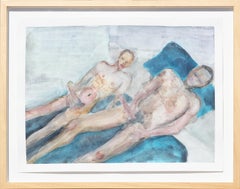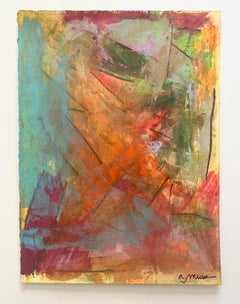Kenny Scharf
Original drawing on Tony Shafrazi poster, signed and inscribed to Andy Warhol's last boyfriend Jon Gould, 1984
Permanent marker drawing on Kenny Scharf Tony Shafrazi Gallery exhibition poster (hand signed and inscribed by Kenny Scharf)
Boldly signed and inscribed to Andy Warhol's last boyfriend Jon Gould
Frame included:
Framed in a museum quality wood frame with UV plexiglass.
Measurements:
Frame:
35 x 28.5 x 1.5 inches
Print
28.25 x 22 inches
Own a piece of Pop Art history!
This is a unique drawing hand signed and inscribed by Kenny Scharf, done on a vintage collectible 1984 poster from the legendary Tony Shafrazi Gallery.
If you saw "The Andy Warhol Diaries" on Netflix, you'd know about Warhol's relationship with Jon Gould - Andy's last boyfriend; tragically, Warhol would become Gould's last boyfriend as well, when, soon after, Gould would die of AIDS at the young age of 33
Kenny Scharf created an original drawing, done in marker, and inscribed it to Jon Gould (featured prominently in Andy Warhol's Diaries and the eponymous Netflix series) - and it had not been seen since the 1980s.
Jon Gould was a New England educated former Vice President of Corporate Communications at Paramount Pictures - a Boston Brahmin whose real claim to fame was as Andy Warhol's last boyfriend. This work was acquired from the widely publicized sale of the collection of Jon Gould - -a treasure trove of valuable gifts and art works by Warhol and others like Kenny Scharf, Basquiat and Keith Haring to Gould - that had not been seen in nearly four decades. This is one of the works from that impressive sale. Below are links to two of the many articles about the collection of Jon Gould in the New York Times, Artnet News and the New York Post respectively.
About Kenny Scharf:
Kenny Scharf (b. 1958, United States) is a renowned artist affiliated with the 1980’s East Village Art movement in New York. Scharf developed a distinct and uniquely personal artistic style in paintings as well as sculpture, alongside his mentor Andy Warhol, and contemporaries like Jean-Michel Basquiat and Keith Haring with whom he pioneered contemporary street art. References to popular culture reoccur throughout his works, such as appropriated cartoon characters from the Flintstones and Jetsons, as well as imagined anthropomorphic creatures. Through ecstatic compositions and a dazzling color palette, Scharf presents an immersive viewing experience that is both intimate and fresh. Scharf’s multifaceted practice—spanning painting, sculpture, installation work, murals, performance and fashion—reflects his dedication to the creation of dynamic forms of art that deconstruct existing artistic hierarchies, echoing the philosophy of Pop artists. Yet Scharf’s artistic significance expands beyond the art historical terrain of Pop Art; the artist instead coined the term “Pop Surrealist” to describe his one-of-a-kind practice. His inclusion in the 1985 Whitney Biennial marked the start of his international phenomenon, a reputation that continues to thrive today.
Courtesy of Almine Rech
MORE ABOUT JON GOULD:
Warhol wrote extensively on Jon Gould in his diaries. In July, 2022, when the Netflix series "The Andy Warhols Diaries" came out, the New York Post (among many other publications) ran a major feature article on Warhol's relationship with Gould and on this very sale: It reads,
"When Harriet Woodsom Gould died in 2016 in her nineties, she left behind a trove of family heirlooms dating back to the 1700s in her Amesbury, Mass., home. Yet in her attic, she had a secret veritable shrine to pop art. There, she had stashed her late son Jon Gould’s belongings for decades since his death in 1986 from AIDS. He had vases painted by Jean-Michel Basquiat, works by Keith Haring and dozens and dozens of gifts — photos, valentines, sketches, letters and more — from pop god Andy Warhol. “My mother kept everything,” Jon’s twin brother, Jay Gould, told The Post. Jay knew his brother “had some type of relationship” with Warhol in the 1980s, though Jon always remained discreet about it. “We were very close, identical twins, but we never talked a lot about his sexuality,” Jay, now 68, explained. “It was a different time.” Yet, he was still stunned to read the poetry and love notes Jon wrote to the older artist. “I didn’t realize the relationship was as deep as it was.” Actually, no one really knew. Gould was Warhol’s last romance, a young Paramount executive with floppy hair and preppy good looks who died tragically at 33. And though Warhol frequently mentioned him in his famed diaries, published posthumously in 1989, the artist’s dashed-off musings gave the impression that Jon was more of a crush than a genuine partner...Gould didn’t so much enter into Warhol’s life as Warhol willed him into it. It was April 1981, and Warhol, then 52, was still reeling from his breakup with Jed Johnson... Jed left that December, and that spring Warhol confessed to feeling lonely: “I’ve got these desperate feelings that nothing means anything. And then I decide that I should try to fall in love, and that’s what I’m doing now with Jon Gould.” Gould was a 26-year-old Paramount exec: a New England WASP with a lithe, strong physique and charismatic personality, who looked straight. Warhol reasoned: “Jon is a good person to be in love with because he has his own career, and I can develop movie ideas with him, you know? And maybe he can even convince Paramount to advertise in Interview, too. Right? So my crush on him will be good for business.” Warhol began courting Gould with a vengeance, sending extravagant bouquets of roses to his office at Paramount. He even offered their mutual friend, the photographer Christopher Makos, a fancy watch if he could get Gould to be his boyfriend. “I guess he never got loved,” Makos says in the series. “Because I didn’t get my watch.” (Jay Gould also tells the camera that his brother had admitted that he was in a relationship but that he said they didn’t have sex.)
At first, Gould resisted Warhol’s attention, but eventually the two began spending a lot of time together, though Gould would frequently pull away if things got too intense, and he often would tell Warhol not to write about him in his diary. “I think my brother was concerned about his career at that time,” Jay Gould said. But the younger man attended parties and art events with him, invited the artist skiing with his family in Aspen and even for a time moved into his place on 66th Street.
“I love going out with Jon because it’s like being on a real date,” Warhol wrote early in their relationship. “He’s tall and strong and I feel like he can take care of me.” Yet it turned out that Warhol would have to take care of Gould. On Feb. 4, 1984, Jon was admitted to New York Hospital with pneumonia — though it was understood that he had AIDS. Warhol stayed with him in the hospital every night for the 30 days he was there, despite his fear of hospitals since getting shot and his fear of getting AIDS. (Warhol couldn’t bring himself to talk about Gould’s illness in the diary, but his editor notes that when Gould was released March 7, Warhol instructed his housekeepers to wash Jon’s clothes and dishes “separate from mine.”). Around 1985, Warhol began working on his massive series of 100 works based on Da Vinci’s “The
Last Supper...





